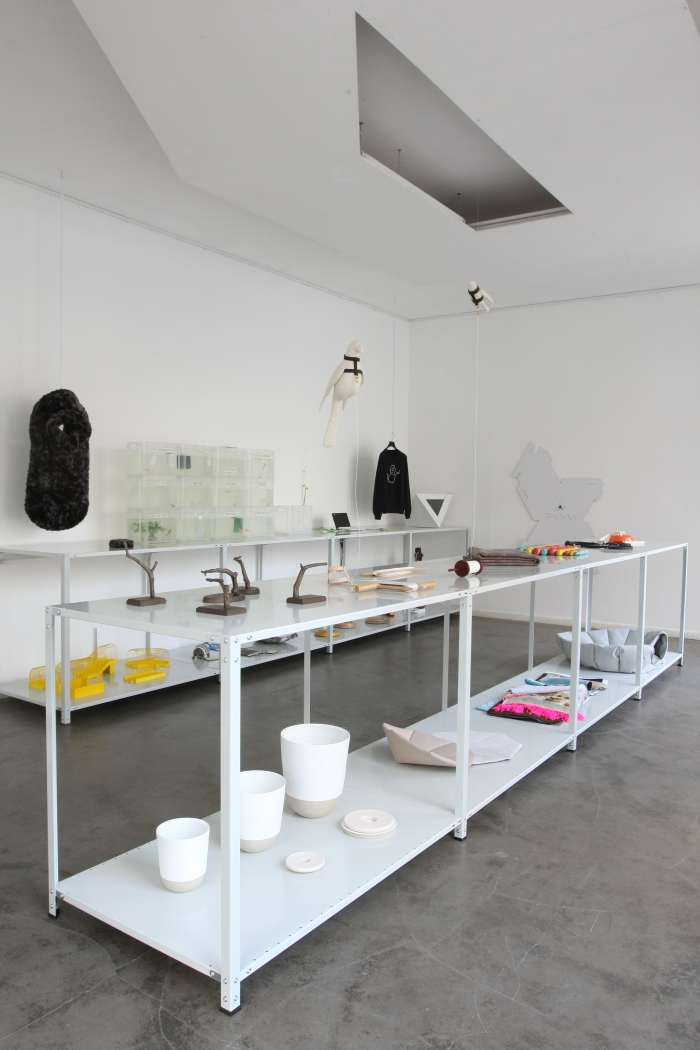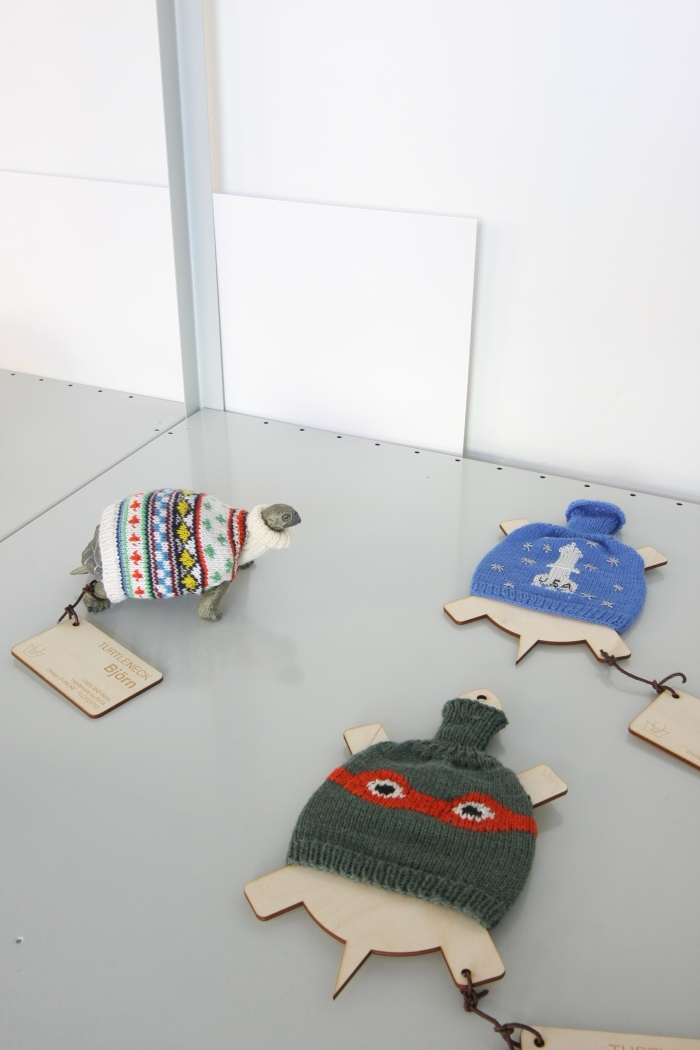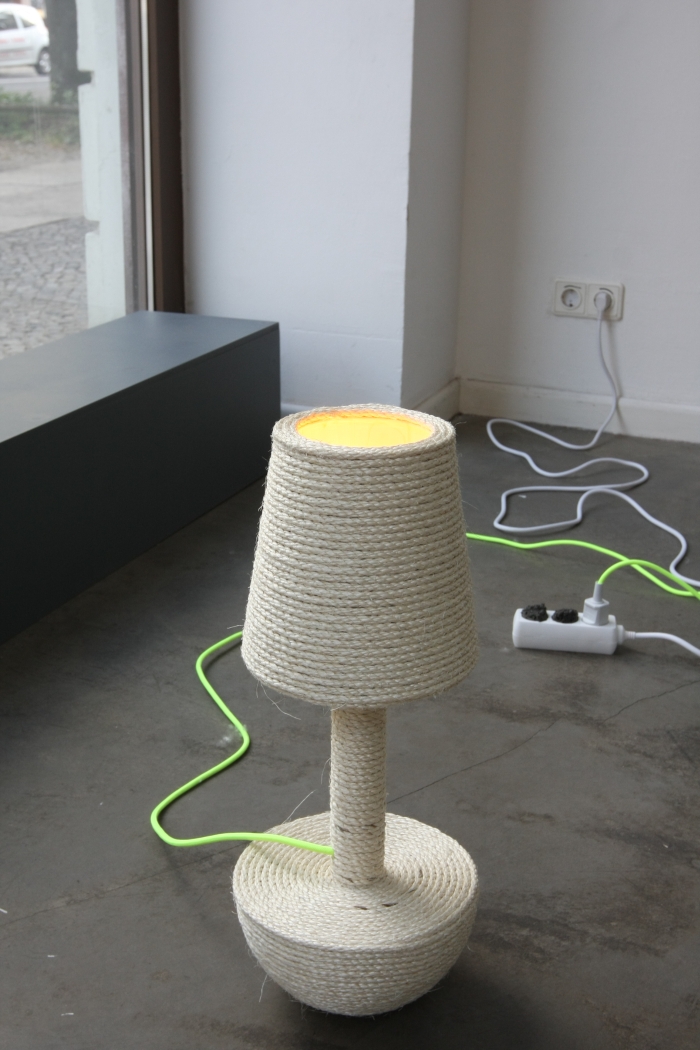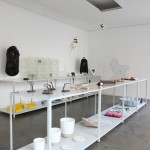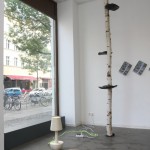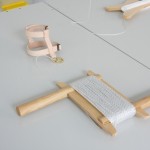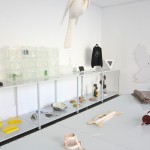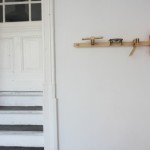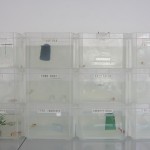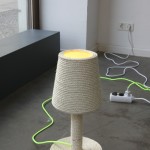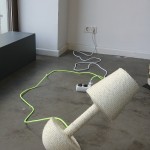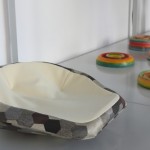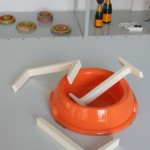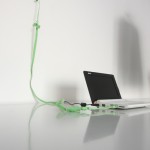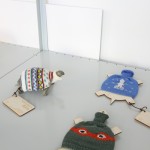DMY Design Spots 2015: Pet Market at Galerie erstererster
Much as we adore our pets they can be troublesome. Be it the cat the refuses to move from your bed, the dog that chews your shoes, pillows, newspapers et al, or the sweary parrot embarrassing us at every (inopportune) moment. If only we could distract them. Maybe we should treat them better? Or at least treat them to better possessions, to objects that meet a standard of functionality and design quality that we demand from our objects. We’re not averse to claiming our pets are family members, why not put as much consideration into the objects they use on a daily basis as we put into those used by our other family members?
Such, or at least similar, thoughts form the background to the exhibition Pet Market currently showing at Galerie erstererster in Berlin
Pet Market began as semester project at the Kunsthochschule Kassel under the direction of Tanja Seiner, who is also curator of the exhibition. “I became aware that we are increasingly sharing our living spaces with animals, that there appears to be ever more pets in our lives”, explains Tanja, “and so I set my students the task of design a product for pets and humans, not just an object for the pet alone, not just an object for the human alone, but an object for both.”
Buoyed by the success of the students works Tanja asked established designers and artists of her acquaintance to do the same. The results of the exercise can be viewed in Pet Market, and range from the sublime to ridiculous, which of course is exactly what you want from such an exhibition, it should, must, push boundaries at both ends.
The practical end of the Pet Market spectrum features object such as Schmoozen by Jennifer Meyer, a shell-shaped cat basket for your lap and which allows you to stroke you’re cat without getting cat hairs on your clothes, perfect for that last bit of togetherness before you head out for the night, or indeed an important business meeting; or the Katon cardboard cat box by Leo Berger, a foldable, stackable box for cats to sit on or sleep in – and developed in cooperation with real cats to ensure it finds feline favour. The more abstract end of Pet Market includes projects such as, well…… lets just say……. BirdKiteKit by Silvia Knüppel, a leather harness attached to a piece of kite rope for taking your pet budgie or parrot for a quick fly, or Christof Flötotto & Sven Funcke’s jumpers for tortoises. Although having said that…. Given that you can buy clothes for other animals, why not your tortoise? Plus with a nice woolly jumper your tortoise can avoid hibernation and thus spend the winter months nice and warm in your living room. And while the product’s name is perhaps zoologically not quite 100% correct, in all other respects it is perfect: Turtleneck
In between these two extremes, and as ever we know and understand that such showcases aren’t a contest, there is no Best of Breed or Best in Show rosettes to be awarded, we were very taken with the Kaze 100, Modell Fungi by Max Kosoric & Sanne Pawelzyk – essentially resting places for cats which can be attached to tress and which resemble bracket fungi and are thus a lovely bit of observational design – and also by the cat scratching lamp Catlights by Silvia Knüppel. The cat scratching post is without question one of the most awful objects ever created. A truly atrocious piece of work and an object derived from Satan’s deep understanding of the human psyche, of the frailties held within and the unrivalled mastery with which his dark sense of humour exploits such. If you want to understand evil, buy a cat scratching post. But a cat scratching lamp: a floor lamp which you can use as a lamp and your cat can scratch, and chase as it rocks back and forth. Brilliant.
Although it is very easy to dismiss an exercise such as Pet Market as nothing but messing about, honestly design for pets? Have we not enough problems in the world? Have you nothing better to do? Designers!!!!
Its not.
On the one hand why shouldn’t pets have access to well designed objects? And no we don’t mean jewel encrusted pipes for cats, hamster bibs, tablet computers for dogs or other “lifestyle” products for those members of society who regularly prove that wealth is inversely proportional to taste; but good quality, intelligently designed objects for pets which improve the life and well-being of both animals in the relationship. And strengthen the relationship. “The majority of products currently available for pets are more concerned with human needs than those of the animals”, says Tanja Seiner, “and while yes when, for example, we have objects for our pets in our homes they must naturally meet certain aesthetic criteria, it is also important that the human needs don’t run roughshod over the requirements of the animals.”
The solution to that balancing act is part of the reason behind the “Market” concept. The visitors should imagine that the objects on display are actually commercially available. Would you buy them? Why? Would you not buy them? Why not? With such questions comes a discourse over our relationships to our pets, what we do for, to and with our pets, what we don’t do for, to and with our pets. Where is the balance? How much of my pet is me? How much of me is my pet. And ultimately, do we need pets? And while interestingly none of the contributors produced an “anti-pet” project, two did produce projects without animal content. PURRRRR by Dietrich Luft, for example, is a wearable fluffy cushion that purrrrrrrrs. And as such is the purrrrrfect cat replacement for the urban worker with neither time nor space for a cat, or indeed those have have both, but no desire to own one. Similarly Olaf Val’s TweetingBitPlant translates incoming twitter messages into bird song, thus you have avian accompaniment to your day, without the cage. Or the swearing.
The “market” concept is also interesting because the pet goods market is one of the few commercial markets where product designers aren’t heavily involved. We have no idea why that is, have many inklings as to why that may be, but nothing we can substantiate. What is however beyond doubt, as Pet Market perfectly demonstrates, is that when asked designers are capable of either developing new products or improving existing objects which bring an added value to pet related goods, a fact which must be in everyone’s interest: designers, manufacturers, consumers, pets.
Finally, and arguably most importantly in terms of the current exhibition, a project such as Pet Market is a valid exercise because it is always good for designers to test themselves in new areas, not least because it brings new perspectives and new ideas into their work. When all is said and done the job of a designer is problem solving, that problem may be an office chair, may be a shelving system, a street light, a blood sugar measuring device….. or something for a cat. It is all the same. But if you only work in one area, with one process, material or object you become stale, lack focus. Trying new things, finding new impulses, new perspectives always helps you develop as a designer, and can also allow you to help wider society reflect in new ways.
The American designer and author George Nelson famously lectured on the benefits a design led approach brings to killing, not because he wanted to make killing more efficient but because he wanted to explain the benefits of good design thinking while highlighting designers responsibilities, and in doing so made 1960s America aware how pointless the arms race was; the Swiss architect Fritz Haller famously designed a space colony, not because he wanted us to live in space but by through the challenge of designing a space colony he hoped to gain fresh insights into how to improve terrestrial colony design, and also make us all think about why we might need a space colony; the Spanish designer Martí Guixé famously created Fish Futures, a series of design objects and spatial features for aquariums. And a project on show as part of Pet Market.
Featuring 13 scenarios including, for example, a chill out zone, a food area and the so-called “aquarium in aquarium” Fish Futures is not about aquarium architecture and piscine pleasure but contemporary social questions, the fish is but the conduit, and as we reflect on what the fish is doing, what it is thinking about the environment in which it finds itself, it its happy, if it is a good solution that the designer has created, if its necessary, we invariably, if unconsciously, place ourselves in the fish’s position and can thus be motivated to swap the world of the fish for the world of our own.
Less an aquarium, more a mirror. And thus an excellent extension of the Pet Market, being as it is as much about the contemporary nature of pet/human relationships as it is about cat baskets, hamster cages or dog bowls.
An intelligently thought through project Pet Market works at both a design theory and design practice level, can however also be enjoyed for the objects on display and what they are, with no need to search for a deeper meaning, a fact which, when combined with the uncomplicated shop-style exhibition design, makes Pet Market an eminently accessible and highly enjoyable exhibition around a subject to which only very few of us rarely give even a modicum of thought.
The exhibition in Berlin is the Pet Market’s public première, but, and all going to plan, not the end. “Ideally I would not only like to show the exhibition elsewhere but also invite further designers to participate” says Tanja, “and for all I would like to involve designers from other cultures because I think that would result in an expression of perspectives on the subject far removed from those of the German designers we have here.”
Design for pets is niche; however, it is a field with a lot of potential, the start Tanja Seiner and her colleagues have made with Pet Market is very promising, we look forward to the continuation.
And to the demise of the cat scratching post.
Pet Market can be viewed at Galerie erstererster, Pappelallee 69, 10437 Berlin until Saturday June 20th
Full details can be found at http://petmarket.world/
- DMY Design Spots 2015: Pet Market at Galerie erstererster
- DMY Design Spots 2015: Pet Market at Galerie erstererster
- BirdKiteKit by Silvia Knüppel, as seen at Pet Market, Galerie erstererster, Berlin
- ….. and in use
- Open Cage by Dominik Hehl, as seen at Pet Market, Galerie erstererster, Berlin
- Fish Futures by Martí Guixé, as seen at Pet Market, Galerie erstererster, Berlin
- Catlights by Silvia Knüppel, as seen at Pet Market, Galerie erstererster, Berlin
- …. and in action
- Schmoozen by Jennifer Meyer, as seen at Pet Market, Galerie erstererster, Berlin
- Bones by Volker Albus, as seen at Pet Market, Galerie erstererster, Berlin
- TweetingBitPlant by Olaf Val, as seen at Pet Market, Galerie erstererster, Berlin
- Turtleneck Christof Flötotto & Sven Funcke, as seen at Pet Market, Galerie erstererster, Berlin
Tagged with: Berlin, DMY, Galerie erstererster, Kassel, Pet Market
